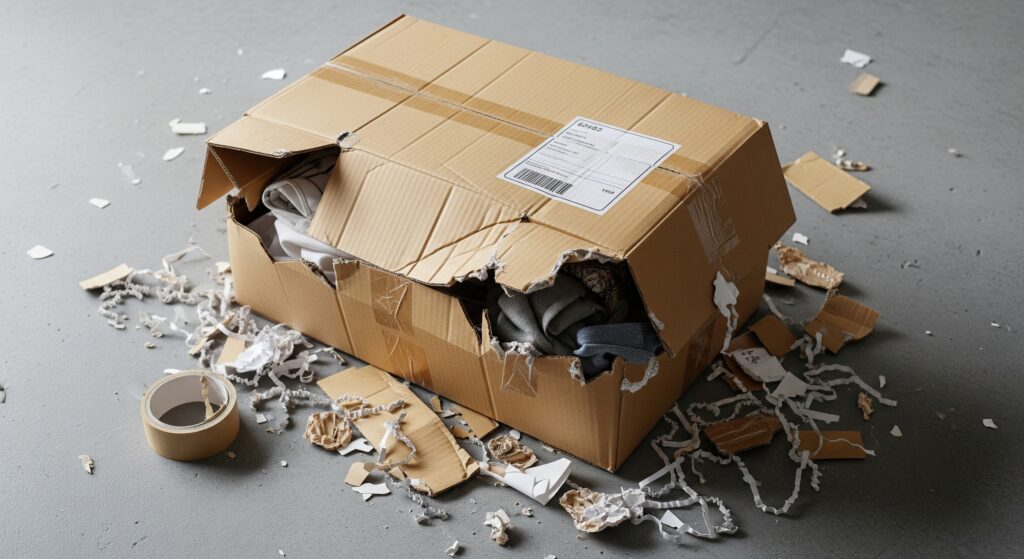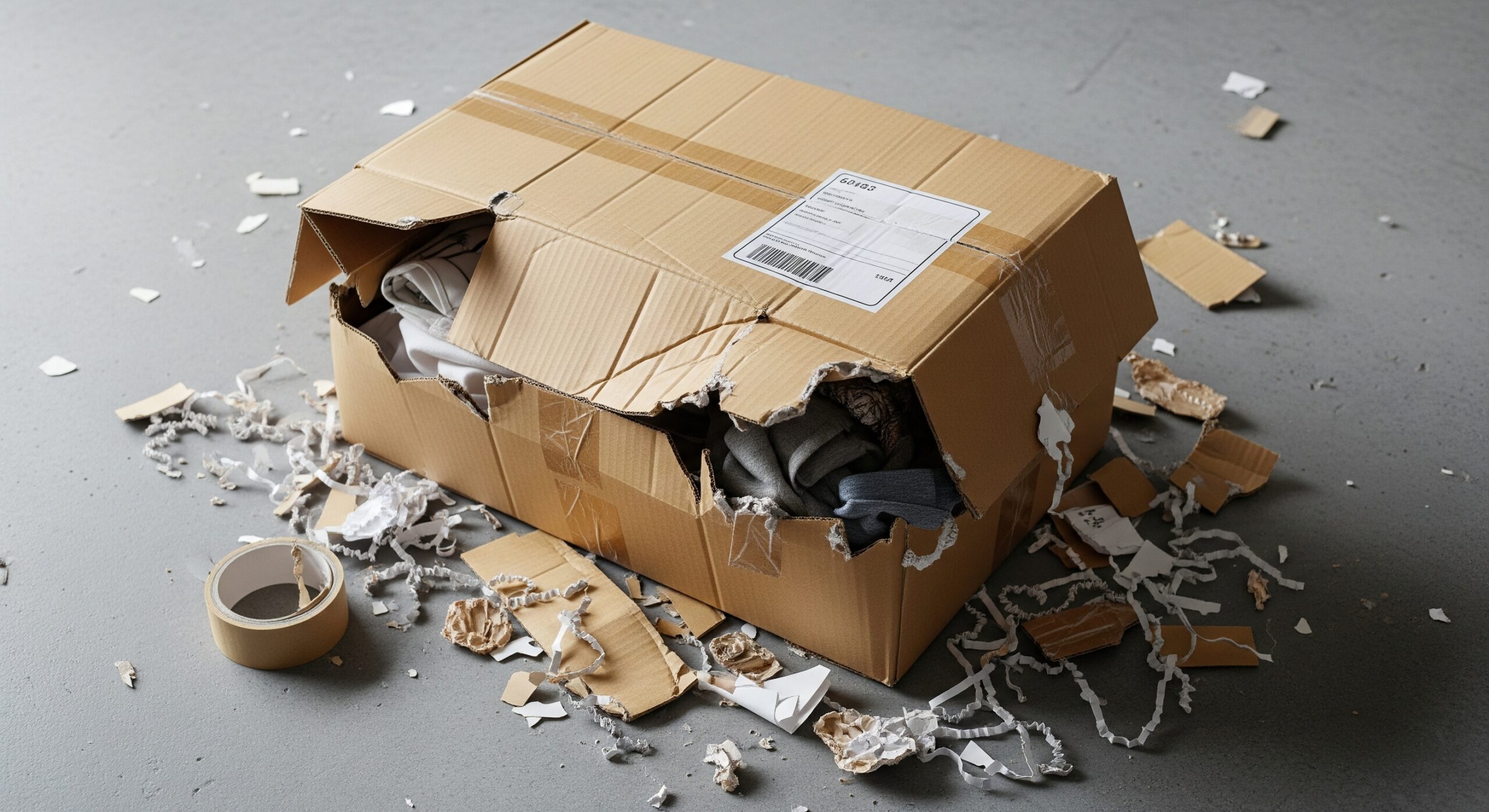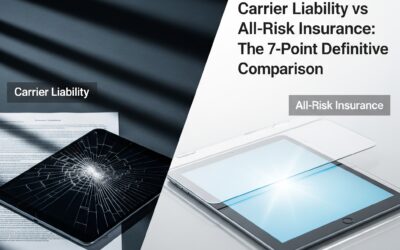Shipping Insurance: Your Guide to Protecting Your Business in an Era of Damaged Deliveries
For any business that ships products, the journey from your warehouse to your customer’s doorstep is the most critical part of your brand’s promise. It’s the final, tangible interaction that represents the culmination of your hard work, your product’s quality, and your company’s identity. But in today’s high-speed, high-volume logistics landscape, that journey is fraught with more risk than ever before.
What happens when your carefully crafted product arrives broken? What is the true cost of a crushed box, a dented container, or a lost parcel? For a growing number of Canadian businesses, these are not hypothetical questions. They represent a daily battle against a system struggling under the weight of its own demand—a battle that directly impacts your revenue, your reputation, and your peace of mind. Without the right protection, specifically the right shipping insurance, you are leaving your business dangerously exposed.
The Alarming Reality: Key Statistics on Damaged Deliveries
The numbers behind this growing crisis are staggering. Recent industry analyses paint a clear picture of the problem across North America, and the projections for 2025 are alarming. Every business owner needs to understand the scale of this issue.
- 85 million packages damaged annually (2025 estimates)
- Nearly 1 in 25 packages arrives with some form of damage
- An estimated $4 billion in lost goods and claims in 2025
- Approximately 45% of online shoppers report having received at least one damaged package in the past year
These statistics aren’t just abstract numbers; they represent millions of negative customer experiences and significant financial losses for businesses. Understanding the forces driving this trend is the first step toward building an effective defense for your business, with comprehensive shipping insurance as its cornerstone.
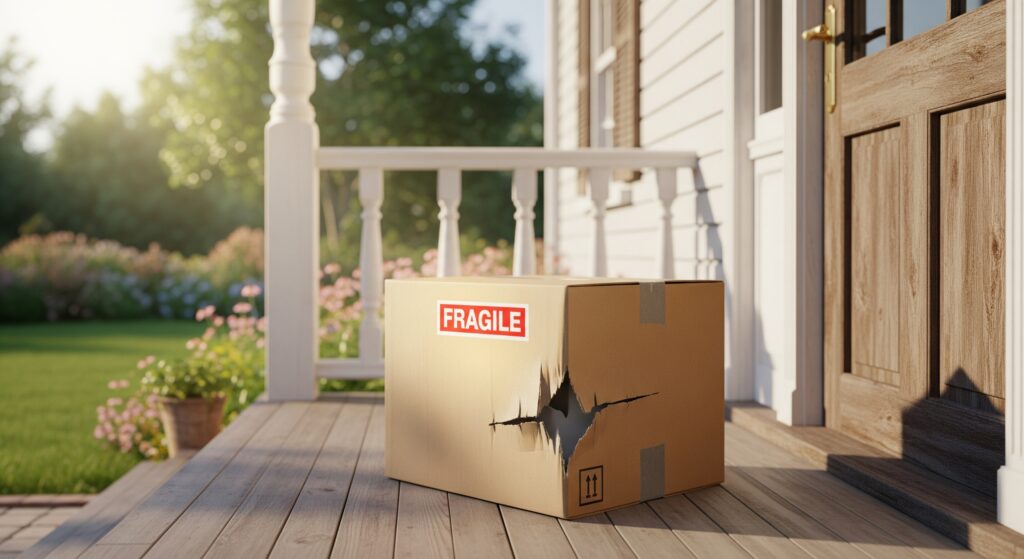
Why Is Package Damage on the Rise? The Five Forces Squeezing Logistics
This surge in damaged goods isn’t accidental. It’s the result of several powerful market forces converging at once, all prioritizing speed and volume over care and quality. For businesses relying on shipping, recognizing these forces is crucial to appreciating the value of robust shipping insurance.
1. The High-Velocity Delivery Model The consumer expectation for near-instantaneous delivery has fundamentally changed logistics. The rise of same-day and next-day delivery models has introduced new networks that rely on gig-economy drivers and micro-fulfillment centres. While incredibly fast, this model often bypasses traditional, more rigorous package handling protocols. Parcels are frequently transported in personal vehicles or delivery bags with less protection, leading to a higher incidence of jostling, crushing, and impact damage. Speed has become the primary goal, often at the expense of careful handling, making a solid shipping insurance policy more critical than ever.
2. The Strain of Overloaded Systems The sheer volume of parcels moving through sorting facilities and delivery hubs is unprecedented. Logistics workers face immense pressure to meet ever-tighter deadlines. In a survey cited by logistics experts, a significant majority of workers admitted to seeing packages being mishandled simply to keep up with the demanding pace. When volume overwhelms capacity, packages can be dropped, thrown, or improperly stacked, leading to damage that could have been easily avoided in a less stressed system. This operational reality underscores the need for shipping insurance as a financial backstop.
3. The Decline in Packaging Standards In a highly competitive market, sellers often feel pressure to cut costs wherever possible, and packaging is frequently the first casualty. To save on dimensional weight charges or material costs, some businesses opt for flimsy boxes, insufficient cushioning, or improperly sealed containers. This is especially prevalent on large online marketplaces where millions of third-party sellers compete. A product packaged inadequately has little chance of surviving the rigors of a high-speed, high-volume delivery network, making robust shipping insurance not just a good idea, but an absolute necessity to cover the inevitable.
4. The “Free and Fast” Subscription Effect The widespread adoption of subscription-based e-commerce models has created a consumer expectation that shipping should always be free and fast. This has fueled an explosion in the number of individual shipments, as shoppers no longer feel the need to consolidate orders. This incredible volume further strains logistics networks and increases the likelihood of handling errors at every stage. Each additional package is another data point demonstrating the need for reliable shipping insurance.
5. The Inflexible Final Mile Despite technological advances, the final mile of delivery remains a major pain point. A lack of personalized delivery options—such as selecting a specific delivery window or easily redirecting a package in-transit—often results in parcels being left in unsafe locations. Packages tossed over fences, left in the rain on a porch, or stolen from a doorstep are all forms of delivery failure. Viral social media stories of mishandled fragile items are a constant reminder that once a package leaves the truck, it faces a new set of risks that only comprehensive shipping insurance can truly cover.
Beyond the Bottom Line: The Cascading Costs of a Damaged Delivery
The financial impact of a damaged shipment goes far beyond the simple cost of the item itself. For a small or medium-sized business, the true cost is a ripple effect that can touch nearly every part of your operation.
- The Obvious Costs: These are the immediate, painful hits to your balance sheet. They include the cost of the damaged product itself, the expense of shipping a replacement item (often expedited to appease an unhappy customer), and the administrative overhead of processing the return and managing the complaint. For high-value items, a single damaged shipment can wipe out the profits from dozens of successful sales.
- The Environmental Cost: In an era of increasing consumer consciousness, the environmental impact of your business matters. Damaged goods contribute significantly to waste. The process of “reverse logistics” – getting the product back from the customer – generates millions of tons of carbon emissions annually from return trips. Furthermore, many damaged products cannot be repaired or resold and end up in landfills, along with the single-use packaging they came in. This hidden environmental toll can damage your brand’s reputation among eco-conscious consumers.
- The Reputational Cost: This is the most damaging and long-lasting cost of all. In the digital age, a single negative experience can be broadcast to thousands in an instant. Negative reviews, angry social media posts, and poor word-of-mouth can permanently tarnish your brand’s image. Studies have consistently shown that customer trust is incredibly fragile. One prominent study found that 73% of consumers are unlikely to purchase from a company again after receiving a damaged item. Every damaged box is a potential lost customer for life. Without a plan that includes solid shipping insurance, you are gambling with your brand’s future with every package you send.
Case Study: The Domino Effect of a Single Damaged Shipment
To understand the real-world impact of these statistics, let’s consider the story of “Northern Craft Co.,” a fictional but highly representative small business based in Brantford, Ontario.
Sarah, the founder, built her business around creating beautiful, hand-thrown artisanal pottery. Each piece was a work of art, and her online store had developed a loyal following. For years, her shipping process was simple and effective. She used standard boxes and plenty of bubble wrap, and damages were rare.
Then, things started to change. The first email was from a customer in Calgary. Her custom-ordered vase had arrived with a large crack. Sarah apologized profusely, immediately issued a full refund, and sent a replacement at her own expense. A week later, another email arrived, this time from a customer in Montreal with a photo of a shattered bowl. Soon, it became a weekly occurrence.
The breaking point came when a customer posted an unboxing video to their popular social media account. The video showed the delivery driver tossing the box, clearly marked “FRAGILE,” onto the front porch from several feet away. The subsequent reveal of the pulverized pottery inside was mortifying. The video quickly gained traction, and the comments were brutal.
For Sarah and Northern Craft Co., the consequences cascaded through the business:
- Direct Financial Loss: The cost of the lost product, the refund, and the express shipping for a replacement completely erased the profit from each sale. Her profit margins, already thin, were evaporating.
- Wasted Labour and Inventory: Every broken piece represented hours of skilled labour and valuable materials turned to dust. Her inventory was shrinking, but her revenue wasn’t growing.
- The Insurance Runaround: Sarah tried to file claims with the carriers. She spent hours on hold, was asked for mountains of paperwork, and was told her packaging might be “insufficient,” even though it had worked for years. The standard $100 of “carrier liability” was a joke compared to the value of her artisanal products. The process was frustrating, adversarial, and ultimately, fruitless. This painful experience highlighted the critical need for a separate, comprehensive shipping insurance policy.
- Eroding Brand Reputation: The most painful cost was the damage to her brand. The social media video and a growing number of negative reviews painted a picture of a company that couldn’t deliver on its promise. She was seeing the harsh reality of customer churn due to poor delivery experiences.
Sarah was trapped. She couldn’t control the actions of a rushed delivery driver or the pressures on the global supply chain. She realized she needed more than just a better box; she needed a comprehensive strategy to reclaim control, starting with a better form of shipping insurance.
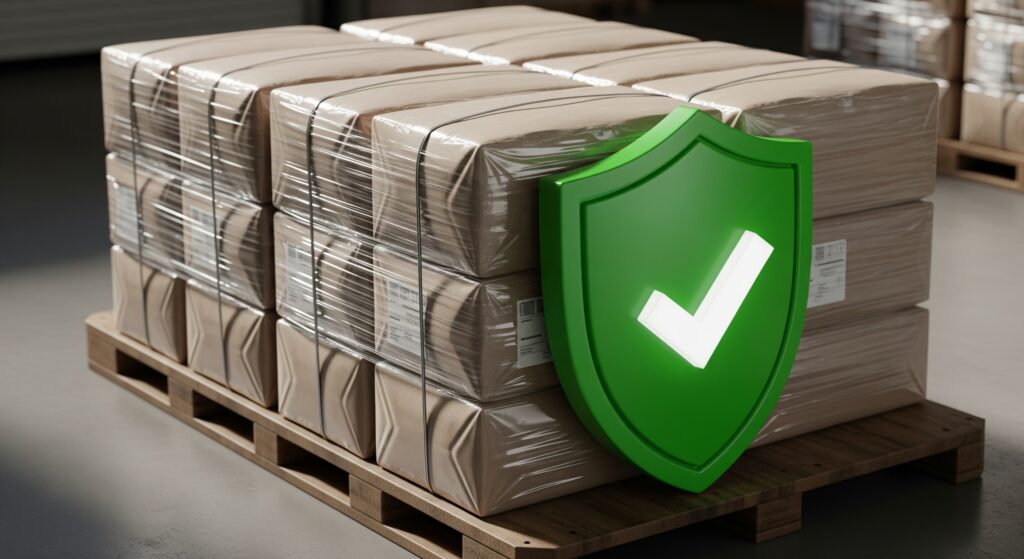
The Solution: A Proactive, 3-Layered Strategy for Protection
The challenges facing Canadian businesses are real, but you are not helpless. By implementing a proactive, multi-layered strategy, you can insulate your business from the risks of shipping damage. This strategy is built on three pillars: physical protection, financial protection, and a partnership that simplifies both.
Pillar 1: Fortify Your Foundation with Bulletproof Packaging
Your packaging is the first and most critical line of defence. While you can’t prevent every mishap, superior packaging can dramatically increase your product’s chances of survival. Think of it as your product’s personal bodyguard. Before you even consider shipping insurance, you must get your packaging right.
- The Box Is Your Stronghold: Start with a new, high-quality corrugated box. For heavier or more fragile items, a double-wall box is essential. The biggest mistake businesses make is reusing old boxes, which have lost up to 60% of their structural integrity.
- Master the 2-Inch Cushioning Zone: Your product should never touch the sides of the box. Aim for a minimum of two inches of cushioning on all six sides. Fill all empty space (void fill) to prevent your item from shifting. Movement inside the box is a primary cause of damage.
- Choose Your Cushioning Wisely:
- Bubble Wrap: Excellent for wrapping individual items and providing shock absorption.
- Kraft Paper: Ideal for crumpling up and using as void fill. It’s affordable and recyclable.
- Air Pillows: Great for filling large empty spaces in a lightweight manner. Best used with non-fragile items.
- Foam-in-Place/Molded Foam: The gold standard for high-value, fragile, or oddly shaped electronics. It creates a custom-fit cradle that offers maximum protection.
- The H-Tape Sealing Method: Proper sealing is crucial for maintaining the box’s structural integrity. Apply strong, pressure-sensitive packing tape along the center seam where the flaps meet, and then apply tape along the two edge seams. This creates a capital “H” on the top and bottom, reinforcing the box’s weakest points against bursting open.
- Label with Clarity: Use clear “Fragile” or “This Way Up” labels. While not a guarantee of careful handling, they provide important visual cues to logistics personnel.
Pillar 2: Secure Your Finances with True Shipping Insurance
Packaging is your physical shield, but what happens when that shield is breached by a catastrophic event? This is where your financial shield comes into play: comprehensive shipping insurance. This is the most critical and most misunderstood part of protecting your business.
The Critical Difference: Carrier Liability vs. Shipping Insurance
The “coverage” automatically included or offered by carriers is not insurance. It is limited liability. This means the carrier will only reimburse you for a small, pre-set amount (often just $100), and only if you can definitively prove they were negligent. This process is intentionally difficult.
True shipping insurance, on the other hand, is a separate policy you purchase to protect the full invoice value of your goods. It is a contract between you and an insurer who is on your side. With the right shipping insurance, you are not at the mercy of the carrier’s internal claims department.
Understanding Your Shipping Insurance Options
- All-Risk Coverage: This is the most comprehensive and recommended type of shipping insurance for most businesses. It covers any and all risks of physical loss or damage from any external cause, unless that cause is specifically listed as an exclusion in the policy. It is broad, simple, and provides the highest level of protection.
- Named Perils Coverage: This type of policy is more restrictive. It only covers losses from the specific causes (perils) that are explicitly listed in the policy, such as fire, theft, or collision. If your package is damaged for a reason not on that list, you are not covered.
Demystifying the Claims Process
A key benefit of true shipping insurance is a claims process designed for resolution, not rejection. While documentation is still required, the focus is on fairness and speed. To ensure a smooth process, you should always be prepared with:
- Proof of Value: The commercial invoice or a receipt showing the item’s value.
- Proof of Damage: Clear photos or videos of the damaged item and the packaging from multiple angles.
- Proof of Shipment: The Bill of Lading or shipping label.
A good shipping insurance partner will provide a simple online portal to upload these documents and will process your claim in days, not the weeks or months it can take when dealing directly with a carrier. Having an easy-to-use shipping insurance claim system is paramount.
Pillar 3: Unify Your Defence with an Integrated Partner
Juggling packaging suppliers, multiple carrier accounts, and a separate insurance policy is complex, time-consuming, and inefficient. The most effective strategy is to unify these elements with a single, reliable partner who integrates protection directly into the shipping workflow.
This is the very reason ShipSimple was founded. We experienced the frustrations of the old, fragmented system and built a solution designed for the needs of modern Canadian businesses. We don’t just offer you access to shipping rates; we offer a complete platform for secure, confident, and insured shipping.
The ShipSimple Advantage: Control, Simplicity, and Peace of Mind
With the ShipSimple platform, you can finally move from a reactive to a proactive state, managing your shipping insurance as a seamless part of your operations.
- Integrated All-Risk Coverage: Add comprehensive, full-value shipping insurance to any shipment with a single click. No separate applications, no complicated forms. We make protecting your shipments as easy as printing a label.
- A Claims Process Built on Trust: Our claims portal is designed for one purpose: to get you paid quickly and fairly. Submit your documentation online in minutes. Our dedicated claims team works on your behalf, with most claims resolved and paid out in a matter of days.
- One Platform, Total Control: Manage everything—quotes, booking, tracking, and insurance—from a single, user-friendly dashboard. This consolidation saves you invaluable administrative time and provides a clear, complete overview of your entire shipping operation.
- Expertise on Demand: We are more than a software platform; we are a team of Canadian logistics and shipping insurance experts. We provide the guidance you need on everything from advanced packaging techniques to understanding international shipping regulations.
The rise in damaged deliveries poses a clear and present danger to your business’s financial health and brand reputation. Stop absorbing the costs of a broken system. By fortifying your packaging, securing your finances with true shipping insurance, and unifying your process with a dedicated partner, you can reclaim control and ship with the confidence you deserve.
Don’t let your business become another statistic. Discover how easy and affordable it is to protect every shipment with ShipSimple.
[Get Your Instant Shipping Insurance Quote Today]
